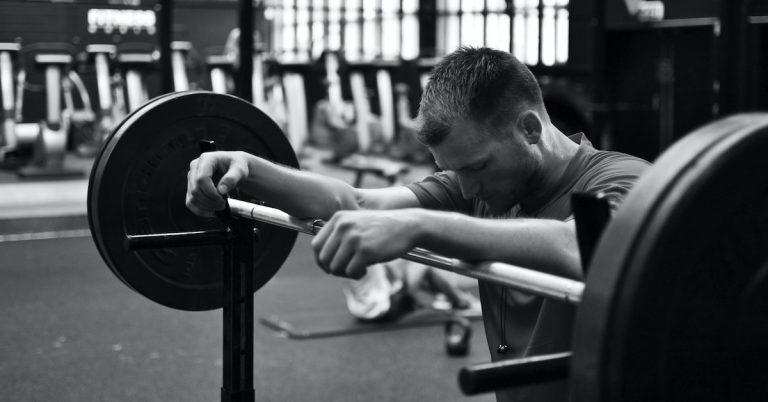If you’ve been in the muscle-building game for a while, you know quite well that you can’t stay on one routine forever. No matter how well you do initially, eventually gains will come to a halt and when that happens, a change is required. The problem is that you can’t just go to your favorite training website and pick any routine that looks cool because a random routine will lead to random results. You need a program that makes sense, one that follows a logical order of progression from the previous routine. Research shows that rotating between periods of higher volume (known as an extensive phase) with periods of higher intensity (intensive phase) is the way to go.
Here are two programs from my book Mass Explosion that will get you started on an extensive-intensive wave of training. These programs are listed in the following manner:
Sequence. Exercise: Sets x Reps @ Tempo, Rest Interval
Both routines involve double station training where you rotate between sets of two exercises. You start with the first set of the A1 exercise followed by the first set of the A2 exercise, then do the second set of the A1 exercise followed by the second set of the A2 exercise, and so on until the prescribed number of sets for each of the two exercises are completed. Follow the same process for the other exercise pairs.
The tempo refers to speed of execution (in seconds) and is represented by a 4-digit number:
- the duration of the eccentric (negative or lowering) action
- the duration of the isometric (pause between negative and positive) action
- the duration of the concentric (positive or raising) action
- the duration of the isometric (pause between positive and negative) action
For example, a 4010 tempo means that you should take 4 seconds to lower the weight, no pause, 1 second to raise the weight, no pause, and then immediately begin the next repetition.
The rest interval is listed in seconds as a specific number (e.g., 120s). If “10s” is specified, move swiftly from one exercise to the next – it should take you exactly 10 seconds from the end of the previous set to the beginning of the next set.
Program 1 – Antagonist Supersets (Extensive Phase)
Day 1 – Shoulders, Back and Chest
A1. Standing Mid-Grip Barbell Press: 3 x 6-8 @ 4010, 10s
A2. Close-Grip Chin-Up: 3 x 6-8 @ 4010, 180s
B1. 45-Degree Incline Neutral-Grip Dumbbell Press: 3 x 8-10 @ 3010, 10s
B2. Seated Mid-Neutral-Grip Cable Pulldown: 3 x 8-10 @ 3010, 150s
C1. Flat Pronated-Grip Dumbbell Press: 3 x 10-12 @ 2010, 10s
C2. Seated Rope Row to Neck: 3 x 10-12 @ 2010, 120s
D1. Bent-Over Cable Crossover: 3 x 12-15 @ 1010, 10s
D2. Seated Dumbbell Lateral Raise: 3 x 12-15 @ 1010, 90s
Day 2 – Legs and Abdominals
A1. Heels-Elevated Barbell Hack Squat: 3 x 6-8 @ 4010, 10s
A2. Seated Leg Curl: 3 x 6-8 @ 4010, 180s
B1. Bent-Knee Hex-Bar Deadlift: 3 x 8-10 @ 3010, 10s
B2. Decline Sit-Up: 3 x 8-10 @ 3010, 150s
C1. Reverse Hyperextension: 3 x 10-12 @ 2010, 10s
C2. Hanging Leg Raise: 3 x 10-12 @ 2010, 120s
D1. Seated Calf Press: 3 x 12-15 @ 1010, 10s
D2. Seated Tibialis Raise: 3 x 12-15 @ 1010, 90s
Day 3 – Arms
A1. Standing Reverse-Grip EZ-Bar Curl: 3 x 6-8 @ 4010, 10s
A2. Tiger Bend Push-Up: 3 x 6-8 @ 4010, 180s
B1. Seated Midline Hammer Curl: 3 x 8-10 @ 3010, 10s
B2. Standing Rope Pressdown: 3 x 8-10 @ 3010, 150s
C1. Standing Twisting Rope Curl: 3 x 10-12 @ 2010, 10s
C2. Flat Twisting Dumbbell Triceps Extension: 3 x 10-12 @ 2010, 120s
D1. Seated Reverse-Grip EZ-Bar Wrist Curl: 3 x 12-15 @ 1010, 10s
D2. Seated Barbell Wrist Curl: 3 x 12-15 @ 1010, 90s
Supersets are a form of strength training where you pair two exercises, moving from one to the next with little to no rest in between. This training method can be quite effective because short rest intervals are known to raise levels of both growth hormone and testosterone, two anabolic hormones that promote muscle growth and body fat reduction.
Supersets allow you to get more work done in any given time frame, and more work will help you get more muscle! By the way, greater workloads are achieved over a number of sets with constant reps rather than constant loads, so lower the weight if you must after each set to stay within the rep range.
Program 2 – Modern Isometronics (Intensive Phase)
Day 1 – Chest, Back and Shoulders
A1. 45-Degree Incline Mid-Grip Barbell Press: 9 x 5 @ 2020, 120s
A2. Mid-Grip Pull-Up: 9 x 5 @ 2020, 120s
B1. Standing One-Arm Neutral-Grip Dumbbell Press: 3 x 8-10 @ 3010, 60s
B2. One-Arm Neutral-Grip Dumbbell Row: 3 x 8-10 @ 3010, 60s
Day 2 – Legs and Abdominals
A1. Back Squat: 9 x 5 @ 2020, 120s
A2. Prone Dorsiflexed Leg Curl: 9 x 5 @ 2020, 120s
B1. Standing Wide-Stance Good Morning: 3 x 8-10 @ 3010, 60s
B2. Kneeling Cable Crunch: 3 x 8-10 @ 3010, 60s
Day 3 – Arms
A1. Flat Close-Grip Barbell Press: 9 x 5 @ 2020, 120s
A2. Standing Mid-Grip Cable Curl: 9 x 5 @ 2020, 120s
B1. One-Arm Overhead Rope Triceps Extension: 3 x 8-10 @ 3010, 60s
B2. 45-Degree Incline Dumbbell Curl: 3 x 8-10 @ 3010, 60s
Isometronics involve lifting through a partial range of motion, usually in a power rack but not always, and finishing each set with an isometric (static) contraction. In this “modern” version, there are four exercises per workout – an A pair and a B pair. You divide the A exercises into three equal ranges of motion (top third, middle third, and bottom third), and do 3 sets of each range for a total of 9 sets. Use a full range of motion on the B exercises.
During the A exercises, the order you perform the three ranges is important. Start with the range that allows the greatest weight to be used – move from ranges where the limbs are extended (where you’re generally the strongest) to ranges where the limbs are flexed.
For all the A1 exercises (i.e., 45-degree incline mid-grip barbell press, back squat, and flat close-grip barbell press), perform the top third of the range first (sets 1-3), followed by the middle third (sets 4-6), and finally the bottom third (sets 7-9). These exercises are performed in a power rack for 5 reps per set using a controlled tempo: 2 seconds to lower the bar, gently and quietly touch the lower pins, and 2 seconds to raise the bar. Then on the fifth rep try to rip through the top rack pin for 8 seconds. If you only have one set of pins in your power rack, then lower the bar just shy of resting on the pins and hold the 8-second isometric there. Make sure not to hold your breath during the static contraction. If you select the proper load, you should not be able to do another concentric rep.
For all the A2 exercises (i.e., mid-grip pull-up, prone dorsiflexed leg curl, and standing mid-grip cable curl), perform the bottom third of the range first (sets 1-3), followed by the middle third (sets 4-6), and finally the top third (sets 7-9). With these exercises, you perform 5 reps again using a controlled tempo (2 seconds up and 2 seconds down), but this time on the fifth rep pause for 8 seconds in the middle of the range.
If you compare both programs, almost double the number of total reps per workout are completed during the antagonist supersets routine; however, greater loads are used with the modern isometronics routine, especially during the strong-range partials.
I’ve only given you a couple of examples above, but there are thousands of programs that you could use to build muscle mass. How you sequence those programs though is important if you wish to make gains over the long haul. The key is to alternate between periods of higher volume with periods of higher intensity.
![Mass Explosion: Blast Through Your Training Plateaus [Paperback]](https://theelitetrainer.com/wp-content/uploads/2019/08/Mass-Explosion-3D.jpg)
Mass Explosion: Blast Through Your Training Plateaus [Paperback]
A new muscle-building system developed by John Paul Catanzaro, author of The Elite Trainer.
Mass Explosion is a comprehensive guide to the art and science of building muscle. This book is filled with the latest, most up-to-date information available.
Learn how to build massive amounts of muscle, naturally. You can obtain “drug-like” effects without the drugs with the right system!
Face it, anyone can increase their size and strength after a few weeks of training, but can they keep getting results after months or years at it?
Sadly, for most people, the answer is no!

My Favorite Leg Finisher
Everything in context! I’m squatting with 225 pounds in the video below. It doesn’t look like much weight except that

How to Get a Biceps Vein
Growing up, all I ever wanted was the “biceps vein!” I wanted it even more than huge biceps. Of course,

Chest and Back Superset
A “super” combo to finish off an upper-body workout involves the standing cable crossover and the bent-over dumbbell lateral raise.
follow
Error: No feed with the ID 2 found.
Please go to the Instagram Feed settings page to create a feed.
